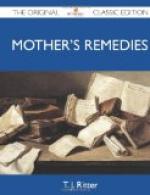Going Away.—When the last guest has been greeted, the bridal party may be served with refreshments. Their supper is laid in a private room, and they are seated, a most welcome rest after the fatigue of the ceremony and the reception. The bride then retires to change to her traveling dress; the bridegroom, who has had his valise sent to the house in the morning, retires for the same purpose. The maid-of-honor accompanies the bride; the best man assists the groom, and packs his suit worn during the ceremony, either to be taken with him or to be sent to his home.
[740 Mothers’ remedies]
At the time agreed upon the bridegroom awaits the bride at the head of the stairs. Adieus to the family are said in the bride’s room and should be brief. The bridesmaids and ushers are awaiting the departure in the hall. Half way down the stairs the bride throws her bouquet. The bridesmaid who catches it will be married next, according to the old superstition. The bride and groom enter their carriage amid a shower of rice or confetti, the carriage door bangs; the caterer has removed the debris of the feast; the maids have restored the house to its wonted order and the wedding is over—all except paying the bills.
Guests at a wedding do not remain until the departure of the bride. They congratulate, partake of refreshments, chat a few minutes with friends, and depart.
At a church wedding it is customary—and usually necessary to keep out the uninvited—to enclose small cards which are presented at the church door to ensure admittance. If the reception is large, the same thing is sometimes done as a measure of protection.
Calls after Wedding.—It is expected that the guests at a wedding breakfast or reception will call on the mother of the bride within three weeks after the marriage, and upon the bride on one of her “At Home” days, or soon after her return from the wedding journey, if no days are specified.
Cards bearing the date of the bride’s “At Home” days, or “At Home after”—a certain date, are enclosed with the announcement cards, or the date named on the card. If sent they must be ready to mail immediately after the wedding.
THE HOME WEDDING.
While the home wedding is modeled in its essentials along the lines of the church wedding, much less formality is observed. The invitations to the church wedding are always in the third person and engraved. Those for the home wedding, though often following the same formula, may be informal notes in the first person, written by the bride’s mother.
Correct Attire.—It is sometimes supposed that a bride married at home may not wear a veil nor be “given away.” On the contrary, if she wears white she may with perfect propriety wear a veil, and the Episcopal marriage ceremony always, and nearly all other forms of the service include the giving away, as implying parental sanction and consent. The “giving away,” then, is customary, even at the simplest home wedding.




